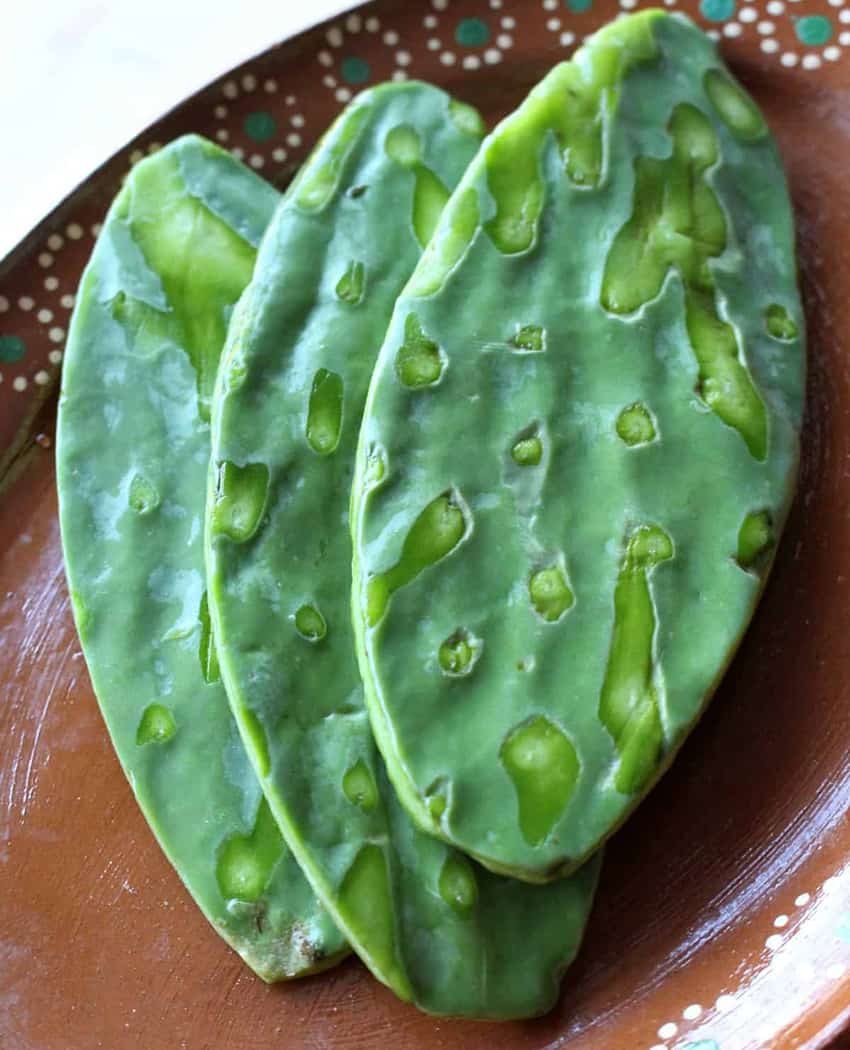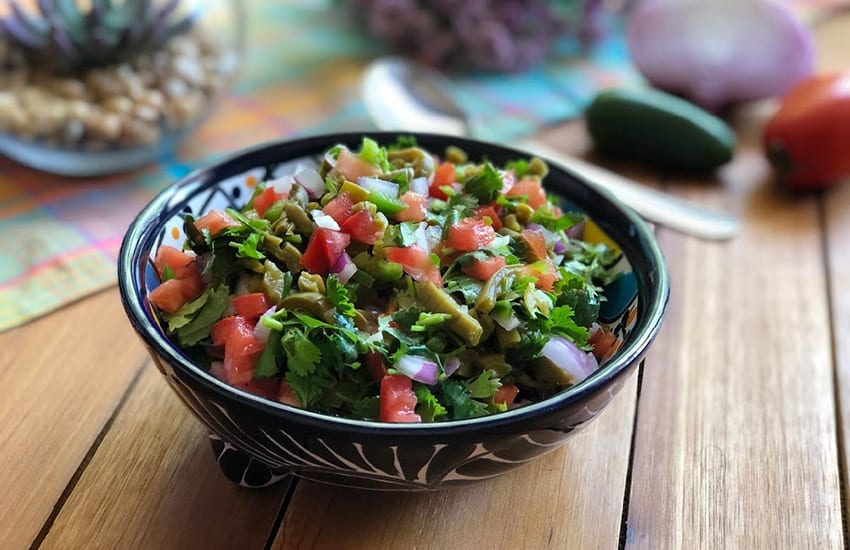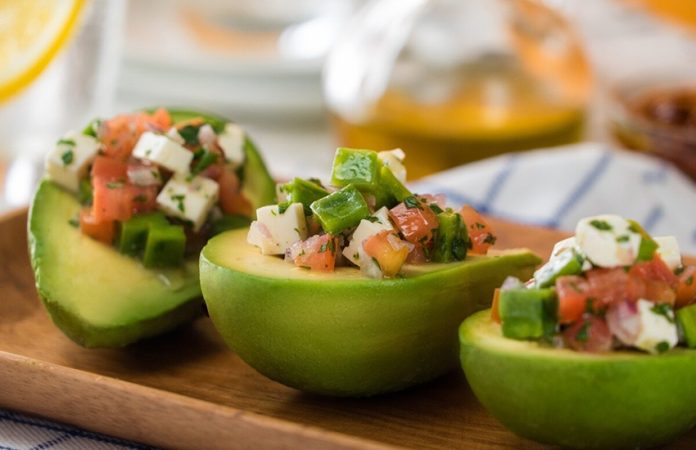Nopal, or nopales — the “paddles” of the prickly pear cactus — are one of Mexico’s most iconic, and to many of us, unusual foods to find in the mercado. (The bright red-to-purplish fruits, called tuna, are also edible, but that’s another story.)
They’re also one of those ancient foods that have been “discovered” to be full of health benefits: nopales are rich in antioxidants, magnesium and Vitamin C; are beneficial for gut health and have immense antiviral properties.
Research has also shown that eating nopal can help regulate blood sugar levels and reduce cholesterol.
Some say eating nopal before a night of drinking can help alleviate the effects of a hangover; you’ll have to be the judge of that!
The word nopal comes from the Náhuatl nohpalli, and there are more than 100 known species of this cactus in Mexico alone.

While you can find them bottled or canned, there’s no reason not to buy them fresh — every mercado and grocery store will have someone cleaning the paddles of thorns, slicing or cubing them, and selling them in bags.
Usually, there are also cooked fresh pieces available too, making it effortless to add them to whatever you’re cooking. They have a not-unpleasant, slightly sour-tart flavor similar to string beans, and, like most veggies, are at their most tender in the spring.
Before nopales can be used in any recipe, they must be cooked to get rid of some of their mucilaginous liquid. There are many ways to do this.
The simplest is to cook the fresh paddles, thorns removed, in a pot filled with water to cover. Add 1 tablespoon of salt, bring to a rolling boil and cook for 10 minutes. Drain and rinse under cold water, rubbing with your hands until all sliminess is gone.
Some say add a few tomatillo husks to the water or a tablespoon of baking soda.
Once you start playing around with nopales, you’ll find lots of ways to use them: chopped and mixed with cheese stuffed inside chicken breasts or rolled skirt steak; diced in omelets, salsa and salads; inside tacos, huaraches and quesadillas or grilled as a simple side dish with meat or poultry.
Nopales with Eggs
Here’s a basic recipe — add other ingredients as you like.
- ⅔ cup nopales, chopped and cooked
- 2 eggs, whisked
- 1 Tbsp. olive or vegetable oil
- 2 Tbsp. chopped onion
- Salt
In a frying pan over medium heat, sauté onion in oil for 1 minute. Add nopales, cook 2 minutes more. Add eggs and cook until tender, stirring gently. Add salt to taste.
Salsa de Nopal
- 1 lb. nopal, cleaned, cooked and diced
- 3 Roma tomatoes
- 1 purple onion
- 1-2 jalapeños
- 1 cup cilantro
- 1-3 limes
- 1 Tbsp. cumin
- 1 tsp. sea salt
Chop all ingredients. Mix with nopal. Season with salt, lime juice and cumin.
Nopales Asados (Grilled Nopal)
Once cooked, wrap in plastic wrap and refrigerate for up to three days.
- 4 nopal paddles, thorns removed
- 2 Tbsp. olive oil
- ½ tsp. salt
Heat grill to 400 F. Rinse and pat dry cactus; brush both sides with oil, sprinkle with salt. Cook on hot grill for 5 minutes each side until cooked through but still tender-firm.
“The Other Green Smoothie”
- 1 medium-sized fresh nopal pad, spines removed, cubed
- 1 cup fresh pineapple, chopped
- 1 cup fresh orange juice
- Optional: ice cubes
Place all ingredients in blender; process until smooth.
Nopales, Potato and Chorizo
Enjoy this on its own, in tacos, or as a side dish.
- 2 cups cooked nopales
- 6 oz. beef or pork chorizo, uncooked
- 1 medium potato, peeled and cubed
- 1½ Tbsp. vegetable oil
- ½ cup finely diced onion
- 1½ cups diced fresh tomatoes
- 1 serrano pepper
- ⅛ tsp. ground cumin
- Salt and pepper to taste
Cook tomato, serrano and 1 cup of water in a saucepan on medium heat until tender, about 15 minutes. Strain out veggies and process in blender with about ¼ cup of cooking water until you have a smooth sauce. Set aside.
Heat oil in a large skillet over medium-high heat. Add potato and cook, stirring, until browned. Add onion, cook 3 minutes more. Add chorizo (casings removed) and cook, stirring, about 8–10 minutes more. When chorizo is cooked, add nopales, then add sauce. Simmer a few minutes to blend flavors, adding more water if needed. Season with salt and pepper.

Stuffed Avocados
- 4 nopal paddles, cleaned and cut in cubes
- ¼ cup salt
- ½ red onion, finely chopped
- 2 tomatoes, cubed
- 1/3 cup panela cheese, cubed
- 1-3 tsp. fresh lime or lemon juice
- 1 tsp. oregano
- 1 tsp. olive oil
- Salt and pepper
- 2 avocados
- 1 Tbsp. minced fresh coriander
In a bowl, mix nopales with salt; rub vigorously with your hands. When the cubes change color, rinse well and drain.
Mix nopales with onion, tomato, panela, citrus juice, oregano, cilantro and olive oil. Add salt and pepper to taste.
Slice avocados in half, remove pit and peel. Fill with salad, sprinkle with more lime juice and serve.
Nopales Salad
- 6 nopales paddles, cooked and chopped
- 1½ cup chopped tomato
- 1-2 serrano peppers, minced
- ½ cup chopped onion
- ¼ cup radish rounds
- 2 Tbsp. lime juice
- ½ cup fresh cilantro, chopped
- Salt and pepper
- 1 tsp. oregano
- ⅓ cup olive oil
- 1 avocado, sliced or cubed
- ½ cup crumbled queso fresco
- Corn tortillas or tostadas to serve
In a large bowl, gently mix nopales, tomato, onion, radishes, serrano peppers and cilantro. In a separate bowl, mix lemon juice, olive oil, oregano, salt and pepper. Add dressing to nopales mixture; stir.
Top salad with crumbled cheese and avocados.
Janet Blaser is the author of the best-selling book, Why We Left: An Anthology of American Women Expats, featured on CNBC and MarketWatch. A retired journalist, she has lived in Mexico since 2006.
